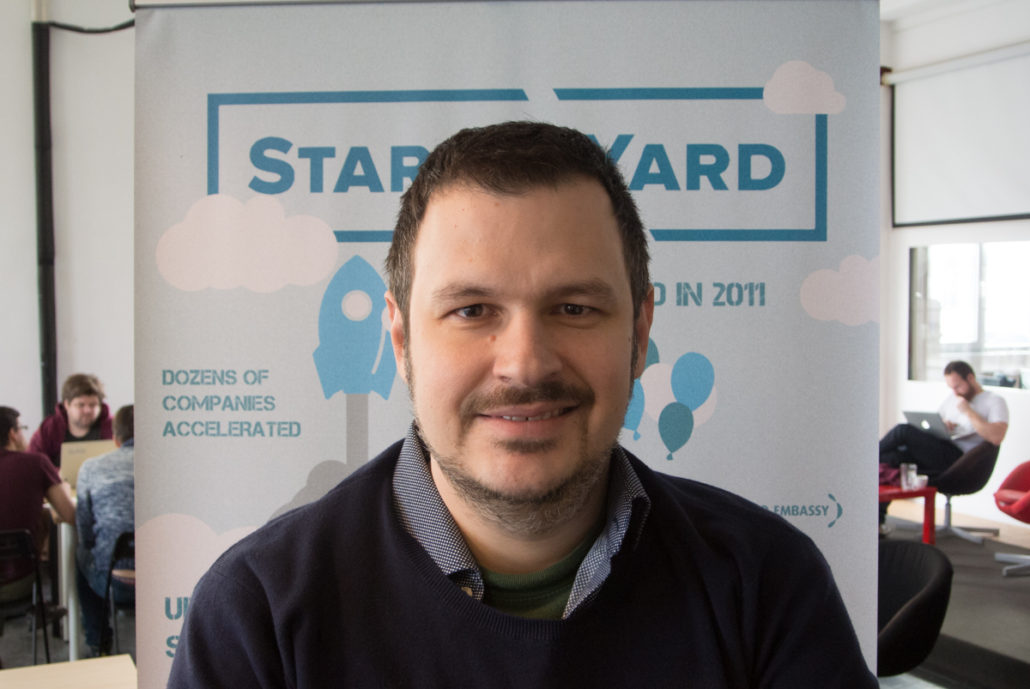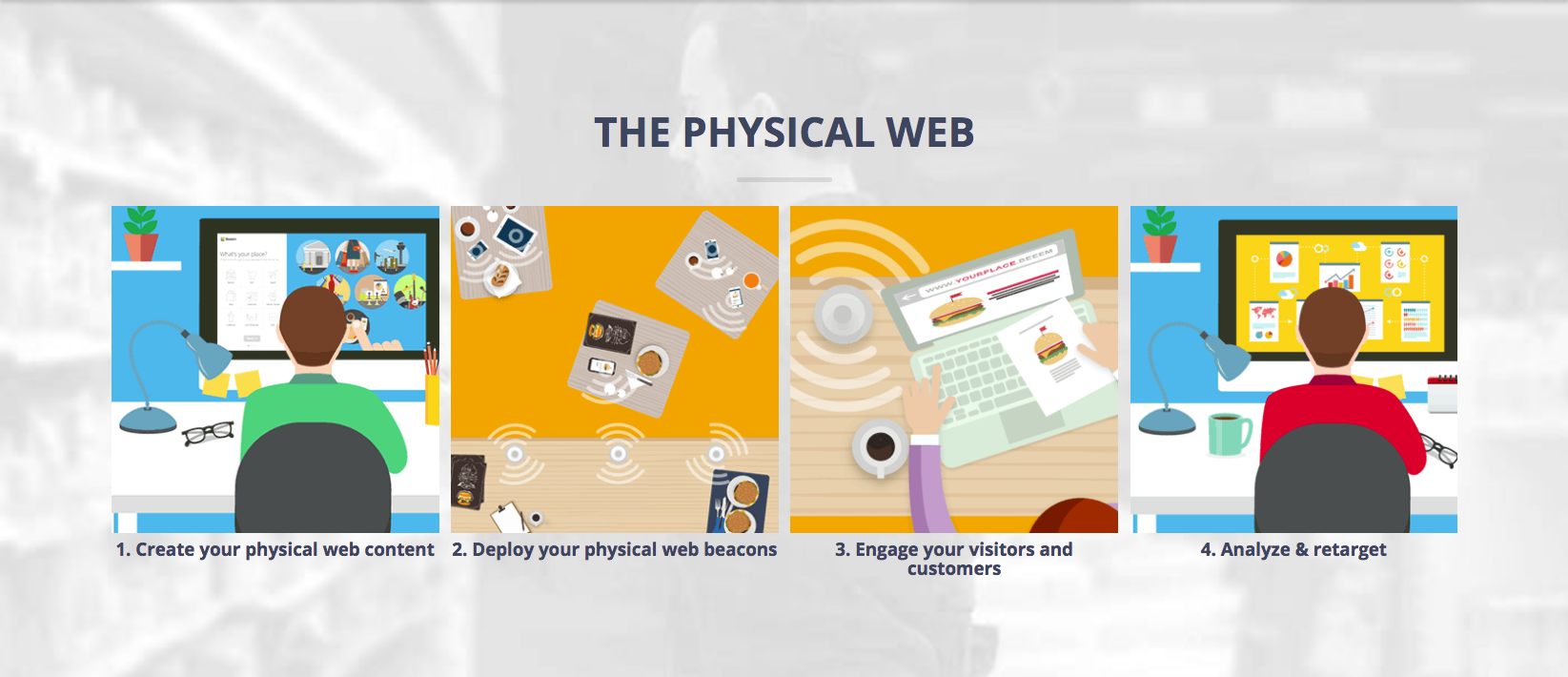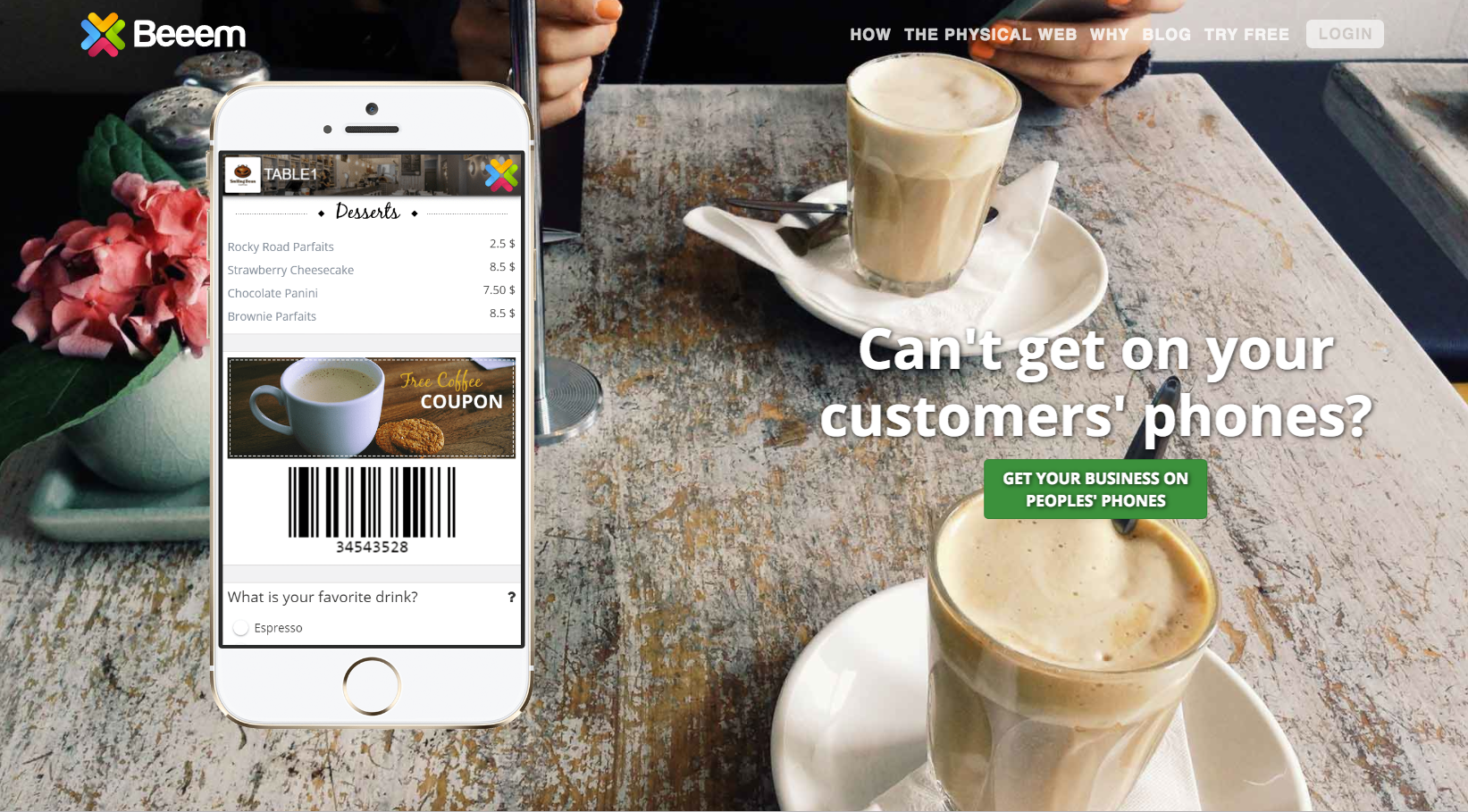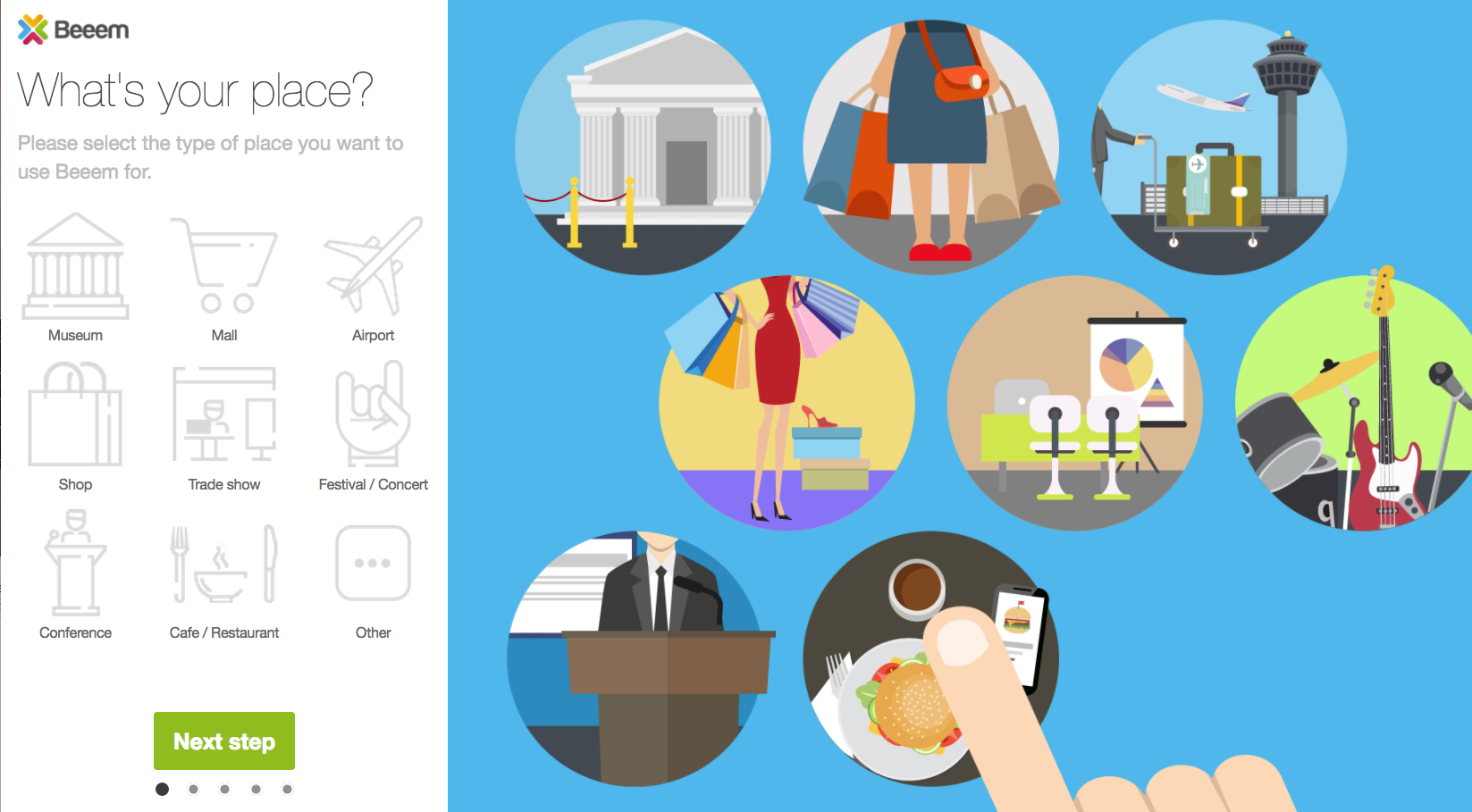Meet Beeem, A Website for Every Thing
Google is betting on beacons. They aren’t the first, but this time it’s with a twist. It initially struck us as odd, that though beacons as a concept have been around for a long time (Apple launched iBeacon in 2013, and we even accelerated an iBeacon startup back then), we had very rarely seen any really practical use case for them. Apple treated iBeacon as a bit of a novelty, failing to establish an attractive platform for developers, or to educate the public on how beacons could be used.
That’s changing– beacon technology may finally be getting its day in the sun. The proliferation of bluetooth enabled smartphones, and the rapidly dropping cost of the physical hardware mean that sooner rather than later, beacons will be an integral part of our experience of the world around us. Google calls it the “Physical Web,” and evangelists inside Google see it as tomorrow’s answer to the disconnect between in-person activities, like shopping, visiting a museum, or taking public transport (or parking… yes even parking), and our lives on the web.
Meet Beeem, the StartupYard 2017 startup that is looking to bring the Physical web to your smartphone. They’re doing it with a “WordPress for the physical web,” a platform that allows pre-configured beacons to broadcast the URL of a microsite which can be launched by anyone nearby using Android or Google Chrome, on any smart device. Beeem helps businesses, event spaces, and others to create web-apps and pages that connect their in-person customers with their web presence, allowing for smart enabled storefronts, content, interactive display ads, customer retargeting online via Facebook and Google, and even payment systems.
With Beeem, a restaurant could easily allow customers to order electronically, without having to wait in line, or a museum could do away with expensive audio-guides in favor of a web-app. An electronics store could allow customers to order and pay from the aisle, rather than lugging their purchases to the counter, and cities could eliminate pay boxes for public transport or parking. To Beeem, the Physical Web means is a website for every thing- the opportunity to create a web presence for virtually any physical object or location, with a central content management system that allows a beacon’s owner to easily configure the web experience it provides.
I caught up with Ferenc Brachmann, CEO and Co-Founder of Beeem, to talk about the Physical Web, and his young company:
Hi Ferenc, how did you come up with the idea for Beeem?
I think this story is going to sound very familiar to anyone who’s ever started a startup, really. I was at a Metallica concert in 2014. I’m really into thrash metal music. Anyway, at the concert, they had a voting system, where fans could vote on their favorite songs, and the band would play them. Pretty cool.
But here’s the thing: they asked fans to vote via SMS. In 2014. To this day I remember seeing the message to vote in an SMS, and looking down at my pimped up new phone with a quad core CPU and 1 GB of memory, and realizing there was something very wrong here. And that got me thinking a bit.

Co-Founder CEO of Beeem, Ferenc Brachmann
Of course, the concept of using the internet to interact live and in person was not new at all. But the fact is that there were essentially two approaches, neither of which work incredibly well. Either you could create your own app or website, and populate it with interactive widgets and forms (and face all the challenges of compatibility and scalability that entails), or you could use a platform designed specifically for the kind of interactions you want, and get everyone to use that.
Metallica could do an app, but then everyone would have to download it and it would still have to connect with something on their back end. Using SMS was the platform solution. It could easily have been some other web service, like Google forms, or one of a hundred voting platforms. It works, kind of, but it leaves a lot to be desired.
For starters, Metallica can’t turn around and leverage all those people who voted via SMS to come to their next show or buy an album. What can they do? Spam them with SMS messages? That won’t work, and it will be really expensive. They don’t own the channel they’re using in that case. The telco owns SMS, and charges a lot to use it despite it being decades old. They’re a gatekeeper.
This issue bothered me for a while, until I went on a trip to South Korea, and had an eye-opening experience. In Korea, mobile internet penetration is basically 100%. It’s everywhere, and it’s fast: you can get a strong connection even in the middle of the Busan Fireworks Festival, which means that there are about 1 Million other people around you in a very small harbour also connected to and using the same networks.
And yet there too, companies like Apple, Google, and Facebook function as the “gatekeepers,” just like the telcos formerly did in the days of SMS. And like the telcos, these big tech companies aren’t necessarily the best medium through which a live venue or a business could communicate with its customers. Their value propositions are all different, and none are a good fit.
WIth Apple, you need an app. That’s a lot of time to download, install, and log-in, not to mention the limited storage space. Google has the same problem with Android apps, or even with search, which requires you to search for the business you’re looking for, only to end up on their website, which is unlikely to work well for communicating with a business then and there.
Facebook is slightly better, especially with their focus on messaging and pages but even there, you don’t have real control over your own audience as a business. And people still ultimately have to actively find you there to connect to you.
So that’s a long story to say: Beeem is the answer to all that. It’s a way for businesses to connect directly with their customers, and to have complete control, without having to rely on any one of these other platforms where they can’t be in control. And it solves the problem of scalability and repeatability that a lot of businesses have, which is: maintaining a web presence takes a big commitment of resources to stay up to date. With Beeem, that part is all taken care of – you’re left just to worry about what you show your customers, and not about which platform to use, or whether your technology is up to date. The future of apps is no apps. No downloading. No waiting. The Physical Web is there when you need it.
Share this:
The Future of Apps is... No Apps. via @beeemapp – a Website for Every Thing. Share on X
Or…
How is your team uniquely suited to taking on the status quo?
After my trip to Korea, I came home and shared my frustration with my friends Norbert and Peter. Norbert is the owner of a software company with a ton of experience, and Peter is the brains behind the biggest e-learning platform in Hungary. I knew they were just the right guys for the job, so we formed a team, and we’ve been working together now for over a year.
Our team is ideal, I think, because we all really love thinking about these very complex problems of how people use technology, how businesses use it, and how the system in general fails to really reconcile these two sides. Once you start looking at some of the behaviors businesses and people have adopted to communicate, it’s really bizarre.

For example, you walk into a store -let’s say an electronics store- and you find an item you think might be the right thing for you. Does this part sound familiar? You probably pull out your phone, a computer more powerful than the sum of all the world’s processing power combined 20 years ago, and you… Google it. You Google it. And Google may or may not tell you what you need to know about the product. Maybe it even offers you a better price, and it certainly shows you ads from the store’s own competitors.
Do you think that makes sense to the store, which is bearing the cost of stocking the product, that its customers can walk in, Google something, and order it for cheaper somewhere else? There have even been movements to ban use of the Amazon barcode reader in stores in the US because of this problem. People would “shop” in stores that they never bought anything from, and Amazon would benefit from the capital costs that the in-person retailer bore to keep the store open.
That’s ultimately bad for the consumer and for the business, because in the end, the platform is going to win that battle. Cheaper is cheaper. Our team is genuinely committed to reversing that problem, and giving in-person retail a new and unbeatable advantage: which is a direct line to a customer who is interested in something right here, right now.
We need in-person retail. The social aspect of shopping and dining will always be important. Perhaps now more so than ever. But these businesses need new tools to fight the battle with the big platforms. That’s what Beeem is all about.
Where do you see the biggest impact for this technology in the next 1-3 years?
I haven’t touched much on what Beeem actually is, so I’ll talk a bit about that.
Beeem is like wordpress for the physical web. The physical web is something that will continue to grow in importance in the coming years, as physical beacons (using Bluetooth), become ubiquitous and cheap. What these beacons do (at least right now), is very simple. They can broadcast a very basic URL. A physical web beacon is detectable from any smart device with Bluetooth, and will continue to be integrated deeper into our devices both on iOS and Android work.
What we do, is help businesses to leverage that technology, by sending anyone within range of that beacon to a web-app that is set up under the complete control of that business. We provide the content management system that supports that web app, and provides the business with easy drag-and-drop tools to build the app that suits their business most. We can support virtually anything a smartphone can do, including easy stuff like messaging, video and audio, and even payments, but also complex things, like live interactive programs and even games that combine the real world and the web.
Ultimately, even beacons themselves will not be that important. Anything electronic will be beacon. A phone, a watch, and soon even a clothing tag can broadcast it’s own webpage, broadcasting useful content and services tied to that object specifically. Soon, you’ll be able to “search” the physical web that is around you, and interact directly with every day objects using your phone, or your watch, or maybe VR glasses, or something else entirely.
That’s why Beeem is an App for Every Thing. Because in the Internet of Things, nothing is very useful unless you can easily and seamlessly connect to it and tell it what to do, or ask it to help you. Beeem allows a business or a venue, or anyone, to target their messaging directly to individuals around them, with customized services, made only for them, based on past shopping habits, or location, or many other factors. It could be kind of like the advertising seen in the in movie Minority Report [starring Tom Cruise].
Do you worry about what this means for privacy?
I don’t. But not because I’m not concerned about privacy or about issues of space and invasive advertising.
The truth is that visions like that in Minority Report tend to get the general idea (ads that talk to you as an individual), but they get the execution all wrong. The truth is that people’s standards shift over time, and technology and business have a way of fitting into new standards as they evolve. For example, I very much doubt that businesses would be successful if they shouted at their customers in the way that ads do in many dystopian future films. In reality, we find that as advertising becomes more targeted, it should become more useful, and the need to be aggressive or “salesy” should actually diminish.
Annoying marketing is also inefficient marketing. It spoils the customer experience rather than giving the customer something they really want. The physical web allows online interaction to be much more efficient, and much more relevant to the customer. Nothing you don’t need- everything you do.
Ultimately, the best form of marketing and advertising is the kind you don’t even consider marketing and advertising, because it gives you exactly what you need, when you need it, and never offers you things you don’t want. We don’t consider the signage inside a store to be advertising, because we choose to see it. The same will be true of the physical web: we will be asking for this information, just as when you walk into a restaurant you are, in a way “asking” to be seated and served.
Let’s talk about some of the use cases right now. What can people do with the physical web and Beeem today?
As of today, you can create a fully customized web-app that your customers can access directly from the notification screen on their Android phones, or via Google Chrome for iOS. We expect that support for the physical web will soon expand in all Chromium browsers (Chrome, Firefox, Opera) and we see hints that other browser vendors will soon join the list.
Businesses, venues, or public spaces like museums and libraries can today create pages for visitors, gather instant feedback or field questions, share content like videos and images, and also receive content from visitors, such as visitor photos or other media.
We will soon be adding e-commerce to this mix, meaning that business can direct customers, with only a single tap on their phones, directly to the portal to purchase items from the store. This could be applied in all manner of environments, from sports events to public transportation. No searching, no downloading- just tap and go.
Those are a lot of diverse and complex areas. Where do you want to focus first, and why?
We’ve been focusing on live events like trade shows, sports, and conferences, because that’s often where the early tech adopters are. There are a lot of people with open minds, and strong incentives to be unique in their fields, so we are targeting hobbyists and geeks to really get a sense of how our customers will use the platform.
In order to scale, we’ll need eventually to shift focus to businesses and use-cases that will be easier to apply to a huge number of customers. Things like retail-location web-apps that let people buy on their phones instead of waiting in line, or restaurant apps that let people order on the go. To accomplish that, we are looking at a mix of online marketing, and cooperating with resellers who already provide payment, IT, or web services to these kinds of customers.
What do you see as not really working in the current status quo?
Well, the status quo certainly works for the gatekeepers. Their ad revenues are built on the lack of penetration that businesses have among their target customers. But ultimately, it just doesn’t make sense for consumers to be directed to 3rd party platforms that aren’t controlled by the companies they are actually doing business with.
There will soon be 5 billion smartphones in the world. Having a handful of platforms funneling all the traffic and keeping all the advertising revenue just isn’t right, or fair. Facebook and Google, as they grow in dominance, can demand more control over what businesses do on their platform, when it should be the opposite.

That forces businesses to play the game of Google or Facebook, instead of focusing on what they do best. It encourages them to be more like others, and less like themselves. And that ultimately costs consumers money. If you can spend your marketing budget more efficiently, and target it at the right people, then you can provide a better service at a lower cost.
We’ve seen this all before in the history of the web. Apple and Facebook could be seen as some later version of Prodigy or AOL – closed systems that wall off huge online communities. Facebook wants people to spend time on Facebook. Not go somewhere else. They want to scoop up all the customers, and control the whole experience of the web in order to make money, just like Prodigy and AOL wanted to before Netscape. The World Wide Web, at least for a while, stopped companies like AOL from doing that. It offered a variety and authenticity a single company couldn’t.
Mobile has given companies like Facebook and Google, and especially Apple, a second shot at end-to-end control of our online experience. They want us to stay in their worlds, and not create anything outside of them. But hey, that’s just not right. I believe it isn’t the way forward for business, or a healthy open society.
Where do you see Beeem in 5 years time?
Powering this revolution of direct, instant P2P communication between everyone and every thing. We aim to be significant in 5 years time, hopefully working towards becoming a global infrastructure provider.
How has your experience with mentorship at StartupYard been? What surprised you?
The mentors have truly been amazing. I personally never thought that you can put such a strong team of mentors together in the CEE region. Out of the close to 70 meetings we had, we had over a dozen fantastic meetings.
A lot of names come to mind but what has really blew my mind is that several mentors have reached out to us afterwards to recommend us or to get more involved in what we’re doing. That really showed me they take this seriously.
I’d like to specifically mention [Former SY Mentor in Residence] Philip Staehelin, [Longtime SY mentor] Tomas Riha, [Springtide Ventures] Karel Tusek and [Axa Insurance CFO] Sebastien Guidoni who all went out of their way and did things that we really did not expect from a mentor.
How has it been for you at StartupYard?
We got accepted to another accelerator in the region, but we decided not to go. We met Lloyd Waldo in Vienna at the Pioneers festival. We had a really good talk and he kind of sold me on the idea that the program here is good. Later I met Cedric Maloux in Budapest and at that time I realized that the program is probably going to be very good for us. Especially because all of Beeem’s co-founders own companies and know business, it’s just that we’ve never owned a startup before.
The startup mindset is all about scaling. It’s about repeating something millions of times. We wanted to get out of our comfort zone, out of our country where we know the market. Even though I had high expectations I think that this program is just spot on. The depth of mentors here is surpassing even my really high expectations. I think Lloyd and Cedric and the gang have their act together. They know how to put you in difficult spots, how to challenge you without you ever knowing about it.






